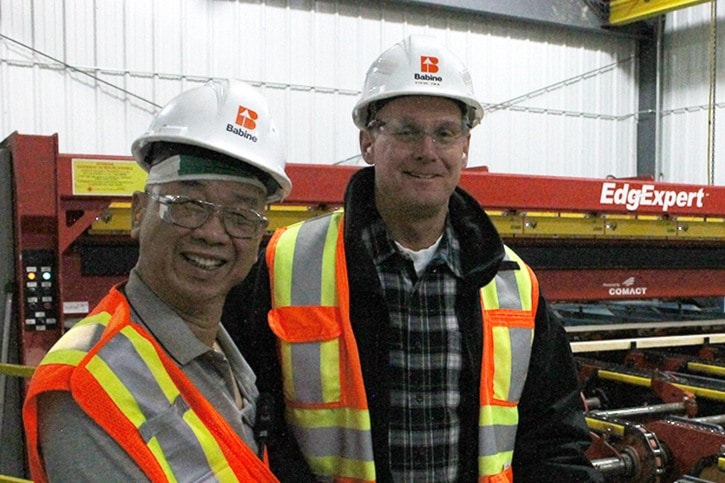Babine Forest Products was officially reopened in April 2014. The new sawmill not only offers a safer and more welcoming environment for workers, but it is also much more efficient than the old one.
The reopening of the sawmill, however, was not an easy process.
Ian Gray, plant manager of Babine Forest Products, recognizes that when the mill started operations again, there was some obvious "nervousness" among employees.
On Jan. 20, 2012, an explosion at the mill cost the lives of two workers, and 20 others were injured. The fire spread throughout the premises and completely destroyed the mill, leaving approximately 230 direct employees without a job.
"When the mill was reopened, there was some apprehension because of what happened, but when we talked to people they were positive," said Gray. "People were happy that the mill was being rebuilt, and glad to come back to work."
The reopening of the mill started with two weeks of training. Councillors were on site assisting employees who may have been experiencing heighten anxiety during the first few weeks. Employees were also encouraged to notify management if they were experiencing any personal difficulties.
The design of the new mill was intended to provide a safer and more welcoming space for workers. The interior cladding and much of the conveyor chuting was painted white. This, combined with energy efficient lighting, improved visibility and created a brighter and safer work environment.
"It looks like an office building," said Steven Zika, Chief Executive Officer of Hampton Affiliates.
Production during the first few months was intentionally slow, according to Zika. Supervisors prioritized making sure that employees were feeling comfortable in new facility, as opposed to worrying about production numbers. Employees, as well as management, needed that time to get accustomed to the new equipment and the new system, he said.
While the old mill required workers manually sorting through lumber, the new mill handles lumber almost entirely through computer controls.
"Machine control and automation are the biggest difference in this new mill," said Gray. "The majority of lumber that goes through the mill will never be physically touched by a person."
The automation not only makes work easier and safer for workers, but it also improves efficiency and production.
"The mill is designed to be able to be successful running lower capacities," explained Gray. "The machines are designed to get the maximum value for every piece of lumber that is coming out of the log."
Another major difference between the old and the new mill is how the cleanup is done. Scrappers and conveyors swap the floor of the new mill, constantly removing pieces of broken wood. This eliminates the need of manual labour almost entirely.
"The new mill almost cleans up itself," said Zika.
Scraper conveyors were constructed under all log decks, lumber decks, the trimmer infeed and outfeed, the stacker and the sorter to ensure those areas are clear of debris throughout hours of operation.
"Now we don't have debris on the floor or on the walkways," said Gray. "When the maintenance crew has to work, the area is clean for them, and fire hazard is reduced."
Zika said that since the incident at Babine Forest Products, as well as the incident at Lakeland sawmill in Prince George in 2012, the entire industry has invested millions of dollars into new dust removal systems.
At Babine Forest Products, new dust extraction systems are designed to capture and collect dust and debris at its source. The systems pull dust and debris from all cutting centres, conveyors and screens throughout the facility. The new mill also has an industrial vacuum system that works much like a central vacuum system in a house.
"It's unfortunate we had to go through the accident, but it has made the whole industry safer," said Zika.
Although the planer was not affected by the fire in 2012, the facility has also received some upgrades. Among the improvements, conveyors were modified to reduce wood debris and dust, and the dust extraction ducting was also upgraded.
Approximately 120 direct employees were rehired for the new mill. However, employees needed to be retrained since the new sawmill relies heavily on computer systems.
"What we have now is a more highly skilled workforce because people have to be computer savvy, versus the old days and the industry of the burly person carrying lumber all over," said Zika.
The vast majority of employees are local, with 95 per cent of them living in the Burns Lake area.
Having a reliable workforce in the area was one of the reasons that helped Hampton Affiliates decide to rebuild the mill, according to Zika.
"In our industry there is a looming shortage of workers," he said. "The whole industry is worried about it and trying to find workers, but we have a good workforce here."
According to Zika, now that employees are used to the new equipment and computer systems, production has also started to speed up.
"We're learning things as we go and we've made some good progress over the last couple of months," he said. "We feel good about the future."
"Employees are feeling more comfortable now," added Gray.
When it comes to the future, Gray was confident to express their vision for the company.
"We want to be a community mill," he said. "We need the help of the community, and we want to be mills that our employees are proud to work at and feel safe coming to work every day."
